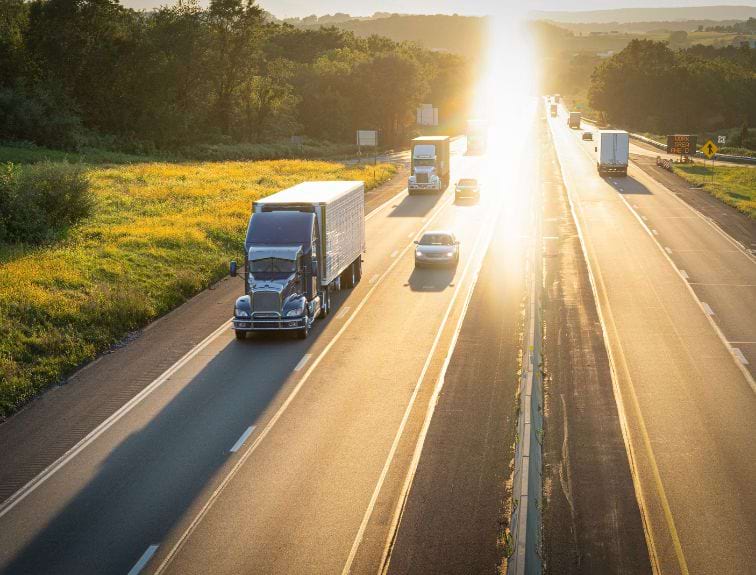When students get their CDL, they mainly focus on what company they want to work for and not on the type of work they will be doing. The three main types of employment for new drivers are OTR (Over the Road), regional, and local driving. While all three of these jobs have similarities, certain differences make it an important decision for all new drivers when considering career options.
Over the Road
OTR driving is the most common job for new truck drivers. Many times, it is the way drivers gain the experience needed to move on to other jobs. While OTR drivers haul similar freight as regional drivers, the main difference is the number of miles these drivers travel to make these deliveries.
- Pros
- Highest pay: Truck drivers are paid by the mile, making OTR drivers the highest paid of the three jobs. The average salary of an OTR driver is around $55,000 starting.
- Travel: OTR drivers are tasked with taking freight across the lower 48 states, which means they get to see the full beauty of the United States.
- Independence: OTR drivers set their driving schedules as long as they deliver their load on time. Drivers are able to drive when they deem best for themselves without anyone constantly looking over their shoulders.
- Cons
- Home Time: Many OTR drivers are gone for weeks, which means that the amount of home time they get is minimal. Most drivers average one day home per two weeks.
- Lonesome: OTR drivers are on the road by themselves for long periods, which gets lonely.
- Health: Drivers have minimal access to healthy food while on the road. This, combined with being behind the wheel for long hours, makes living a healthy lifestyle hard but not impossible for drivers.
Regional
Regional trucking is the best blend of OTR driving and local driving. For regional drivers, their work is focused within geographic regions of the United States. These regions usually are 4-5 states and don’t go past a 1000-mile range. Regional drivers also have more dedicated routes to deliver to instead of the independence that OTR drivers have.
- Pros
- Home-time: Regional drivers spend the week on the road but can come home on the weekends to spend time with family.
- Travel: Drivers can still see the US as they drive throughout their region, but they have less travel time than OTR drivers.
- Relationships: Regional drivers can make relationships with customers as they are likely to make deliveries to the same customer repeatedly.
- Cons
- Stricter Deadlines: Many of the jobs that regional drivers take will be back-to-back to return to their home state. Many jobs will have tight turnaround times, which can leave the driver stuck in their truck.
Local
Local drivers typically deliver in a 100-mile radius which means they can be home in the evenings. These drivers also tend to make the same deliveries each day.
- Pros
- Home-time: Since local drivers operate within a 100-mile radius, they can return home for the evenings during the week and could be off on the weekends depending on the company they work for.
- Health: Being home for dinner and close to home for other meals means that local drivers have easier access to healthier meals. Local drivers are also in charge of loading and unloading their trucks, leading to less time sitting behind the wheel.
- Consistent routine: Local drivers are given their routes and deliveries at the start of the day, which provides the driver with the ability to schedule things outside of work.
- Relationships: Drivers build relationships by making constant deliveries to the same people over time. Local takes this to the next level as drivers build relationships daily with customers. They also are able to stay in close contact with their families.
- Cons
- Pay: Due to local drivers not traveling as far, the pay opportunities are less than regional or OTR drivers. The average starting salary for local drivers is $41,000.
- Manual Labor: Regional and OTR drivers, once they have arrived at a pickup or drop-off point, their part of the job is mostly over as there will be a team that loads or unloads their truck. Local drivers load and unload the truck on their own, which leads to more manual labor for the driver.
- Longer hours: Many local drivers work similar hours to OTR drivers; however, they usually don’t get to choose when they start and stop. Many drivers feel like they get home just in time to go to sleep and start the next day again.
Students who graduate with their CDL have many options available to them to decide which type of job they take. Recognizing the difference between the three types of driving jobs will help students decide what career option best suits them.
Now that you’ve seen not all trucking jobs are the same, contact DriveCo to get your CDL and get started today!




